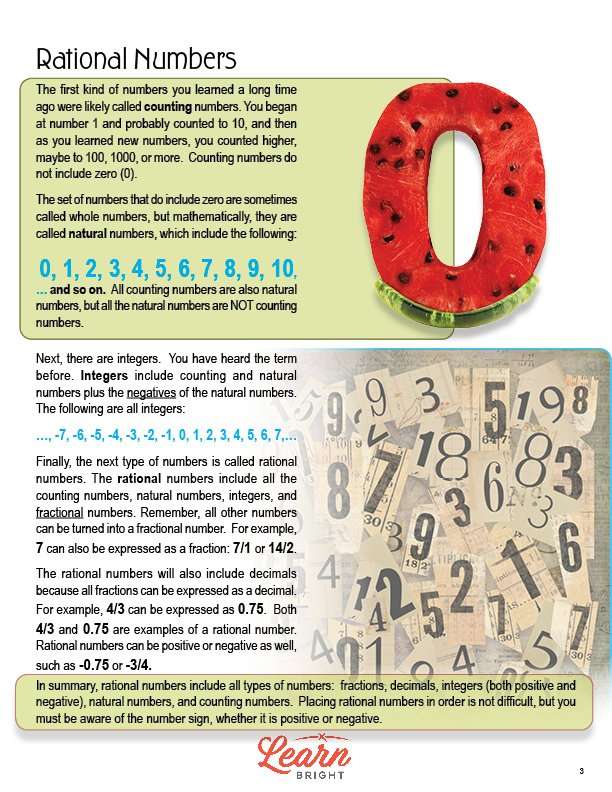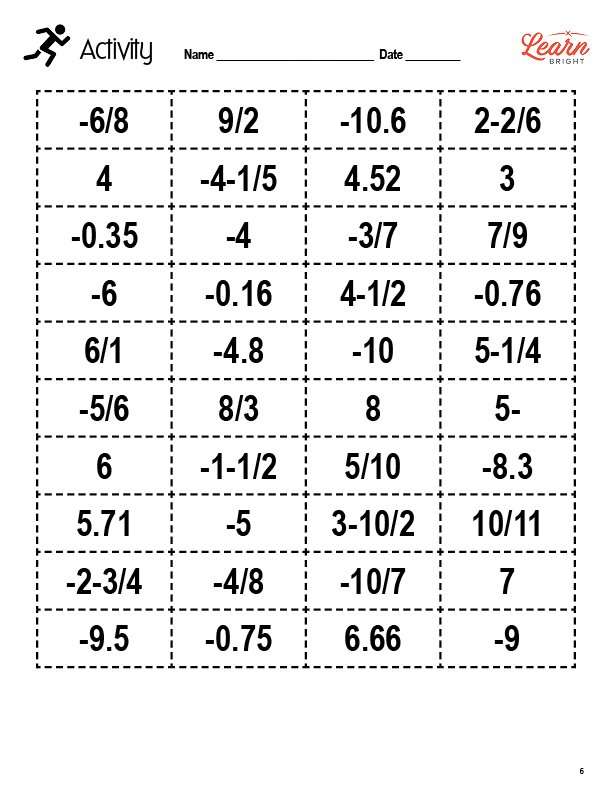Description
What our Put Rational Numbers in Order lesson plan includes
Lesson Objectives and Overview: Put Rational Numbers in Order teaches students strategies for determining the order of a set of rational numbers. At the end of the lesson, students will be able to define an integer and place integers in sequential order from least to greatest and greatest to least. This lesson is for students in 6th grade.
Classroom Procedure
Every lesson plan provides you with a classroom procedure page that outlines a step-by-step guide to follow. You do not have to follow the guide exactly. The guide helps you organize the lesson and details when to hand out worksheets. It also lists information in the blue box that you might find useful. You will find the lesson objectives, state standards, and number of class sessions the lesson should take to complete in this area. In addition, it describes the supplies you will need as well as what and how you need to prepare beforehand.
Options for Lesson
Included with this lesson is an “Options for Lesson” section that lists a number of suggestions for activities to add to the lesson or substitutions for the ones already in the lesson. One optional addition to the lesson activity is to have your students place the activity numbers in order from least to greatest and from greatest to least. For additional practice, you could have your students pick five numbers at a time to list from least to greatest or greatest to least. Finally, you could have each student write five rational numbers on a slip of paper, collect them all, and then have your students randomly pick five and place them in order.
Teacher Notes
The teacher notes page includes a paragraph with additional guidelines and things to think about as you begin to plan your lesson. This page also includes lines that you can use to add your own notes as you’re preparing for this lesson.
PUT RATIONAL NUMBERS IN ORDER LESSON PLAN CONTENT PAGES
Rational Numbers
The Put Rational Numbers in Order lesson plan includes two content pages. The first kind of numbers that you usually learn about are counting numbers. They start at 1 and, as you learn more numbers, keep getting bigger. Counting numbers don’t include zero.
Natural numbers do include zero. They include 0, 1, 2, 3, 4, 5, 6, 7, 8, 9, 10, and so on. All counting numbers are also natural numbers, but all natural numbers are not counting numbers.
Integers include counting and natural numbers, but they also include the negatives of natural numbers. Integers include …-7, -6, -5, -4, -3, -2, -1, 0, 1, 2, 3, 4, 5, 6, 7, and so on.
Finally, rational numbers include counting numbers, natural numbers, integers, and fractional numbers. Remember that you can turn all numbers into fractional numbers. For example, you can write the whole number 7 as a fraction: 7/1 or 14/2.
Rational numbers also include decimals, because you can turn all fractions into decimals. For example, you can write 4/3 as 0.75. Both 4/3 and 0.75 are rational numbers. Rational numbers can be positive or negative.
To summarize, rational numbers include all types of numbers: fractions, decimals, integers (both positive and negative), natural numbers, and counting numbers. It’s not hard to place rational numbers in order, but you must remember to always pay attention to whether each rational number is positive or negative.
Ordering Rational Numbers
Let’s look at a set of numbers: 4, 7, 0, 2, and 8. It’s very easy to put these numbers in order from least to greatest (0, 2, 4, 7, 8) or from greatest to least (8, 7, 4, 2, 0). These are all natural numbers.
However, when you’re placing rational numbers in order, you need to pay attention because you may have several different kinds of numbers mixed together. In some cases, you will need to change fractions to decimals or whole numbers, focus on an integer’s sign as positive or negative, or be aware of other negative and positive rational numbers.
Let’s look at a set of rational numbers and place them in order from least to greatest: 2, -5, 0.9, -3/5, 2.5, -5.2, 1/2, 3, 0, and -1.1. Many people will look at these numbers and think that 0 is the smallest number. However, some of the integers in the list are negative, and all negative numbers are smaller than zero. Therefore, this set of numbers, in order from least to greatest, is: -5.2, -5, -1.1, -3/5, 0, 1/2, 0.9, 2, 2.5, 3.
Remember to always focus on the signs and change fractions and decimals to whole or mixed numbers when ordering rational numbers from least to greatest or greatest to least.
PUT RATIONAL NUMBERS IN ORDER LESSON PLAN WORKSHEETS
The Put Rational Numbers in Order lesson plan includes three worksheets: an activity worksheet, a practice worksheet, and a homework assignment. You can refer to the guide on the classroom procedure page to determine when to hand out each worksheet.
WAR ACTIVITY WORKSHEET
Students will work with a partner to complete the lesson activity by playing a game of War. Each pair will begin by cutting out and fold the numbers printed on the worksheet. Next, each player will randomly choose 40 of the numbers. In game 1, the greatest number wins. In game 2, the least number wins.
COUNTING, NATURAL, INTEGER, RATIONAL PRACTICE WORKSHEET
The practice worksheet asks students to first read five statements related to the lesson material and decide if they’re true or false. Next, they will look at five numbers and determine if they’re counting, natural, integer, or rational. Finally, they will place seven sets of numbers in order from least to greatest.
PUT RATIONAL NUMBERS IN ORDER HOMEWORK ASSIGNMENT
For the homework assignment, students will first look at sets of numbers and circle the greatest number and draw a box around the least number. Next, they will place sets of numbers in order from least to greatest. Finally, they will give examples of counting, natural, integer, and rational numbers.
Worksheet Answer Keys
This lesson plan includes answer keys for the practice worksheet and the homework assignment. If you choose to administer the lesson pages to your students via PDF, you will need to save a new file that omits these pages. Otherwise, you can simply print out the applicable pages and keep these as reference for yourself when grading assignments.









